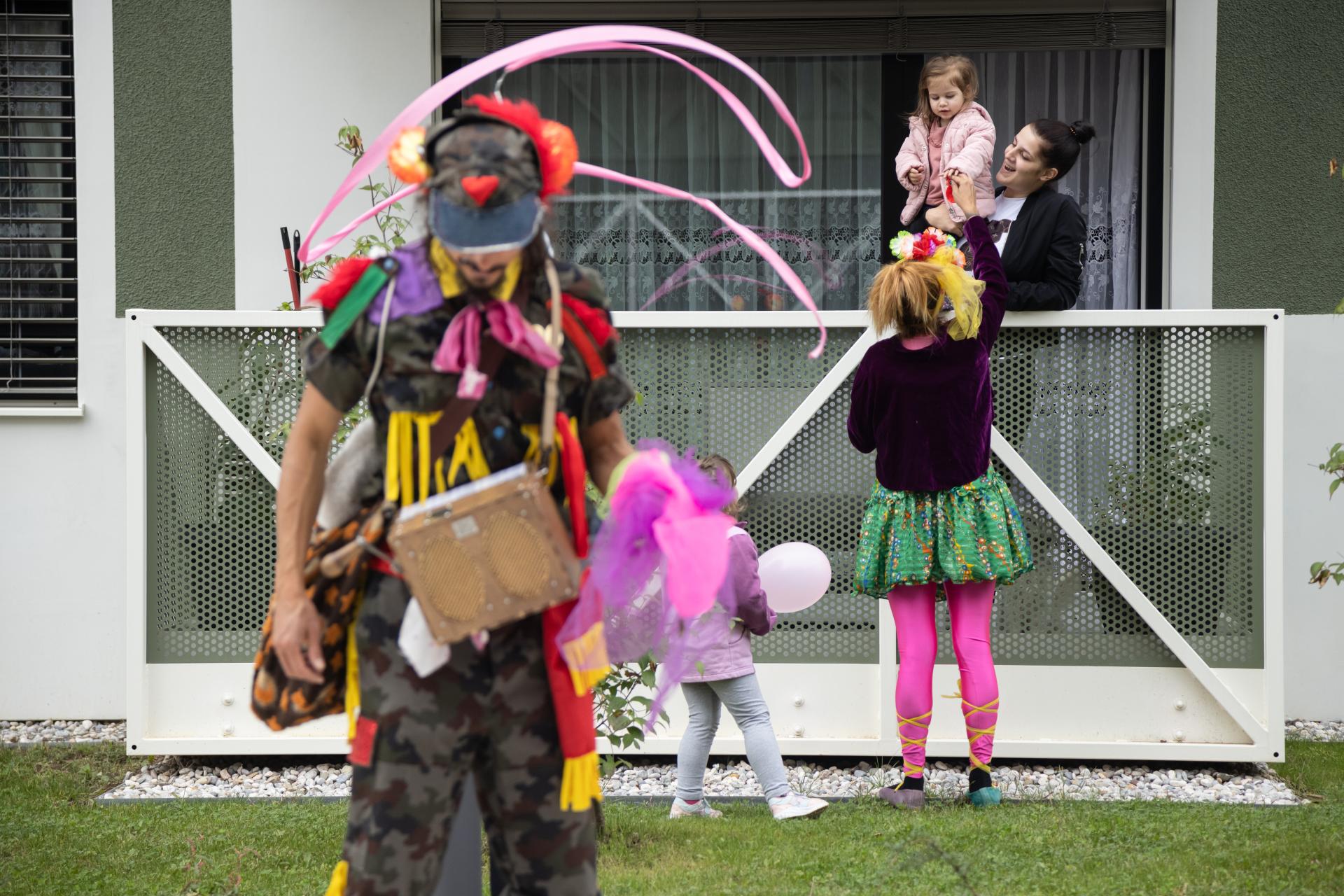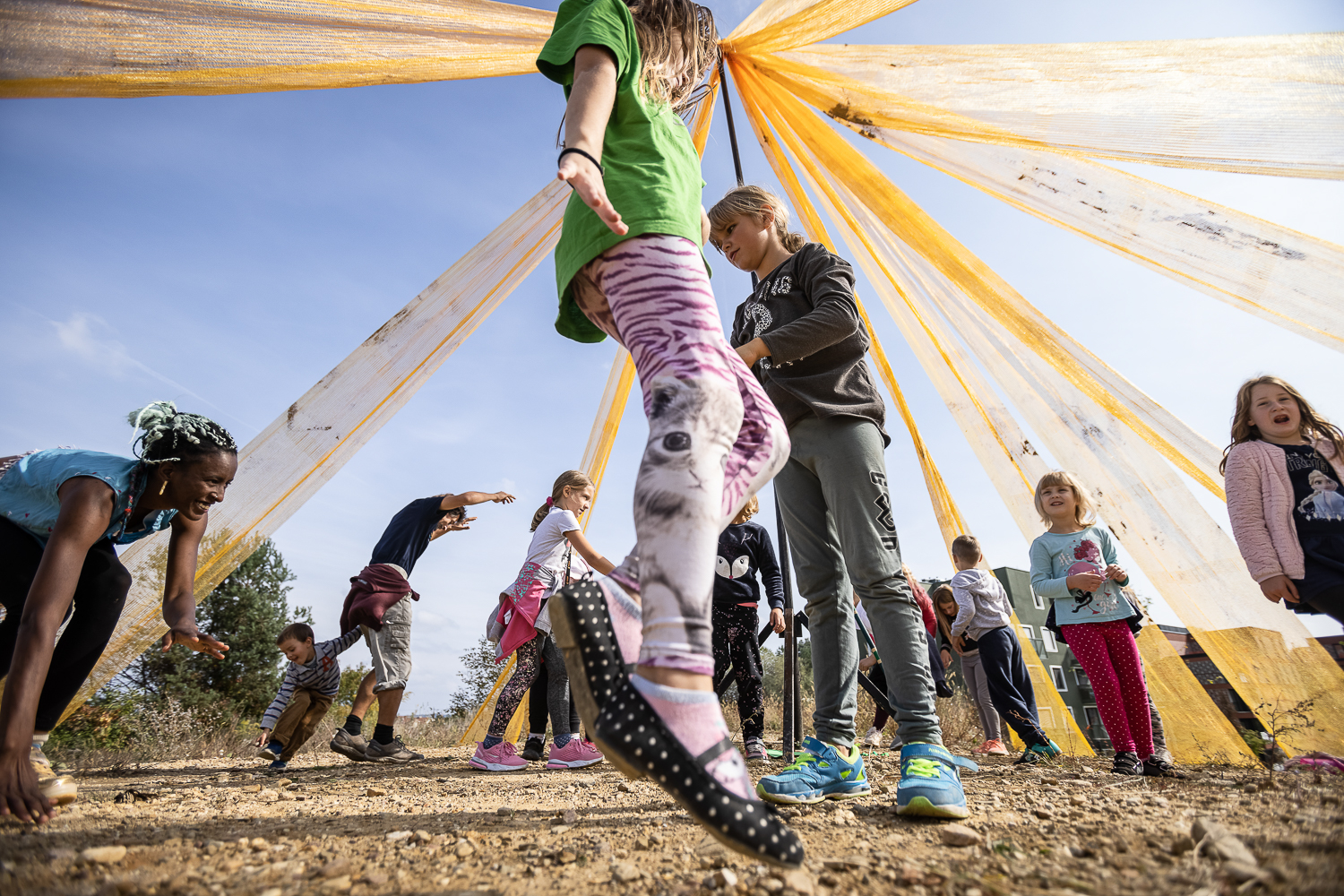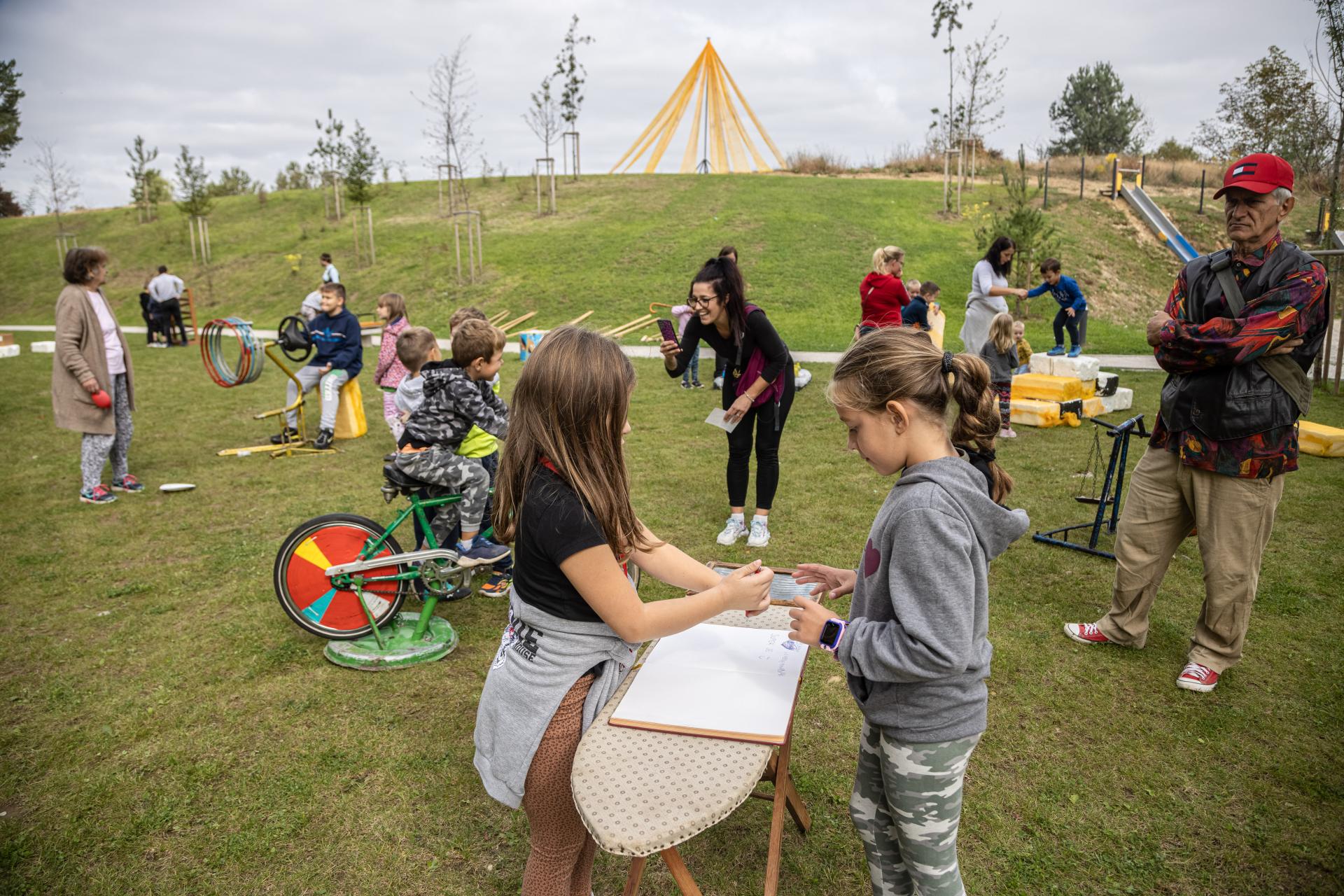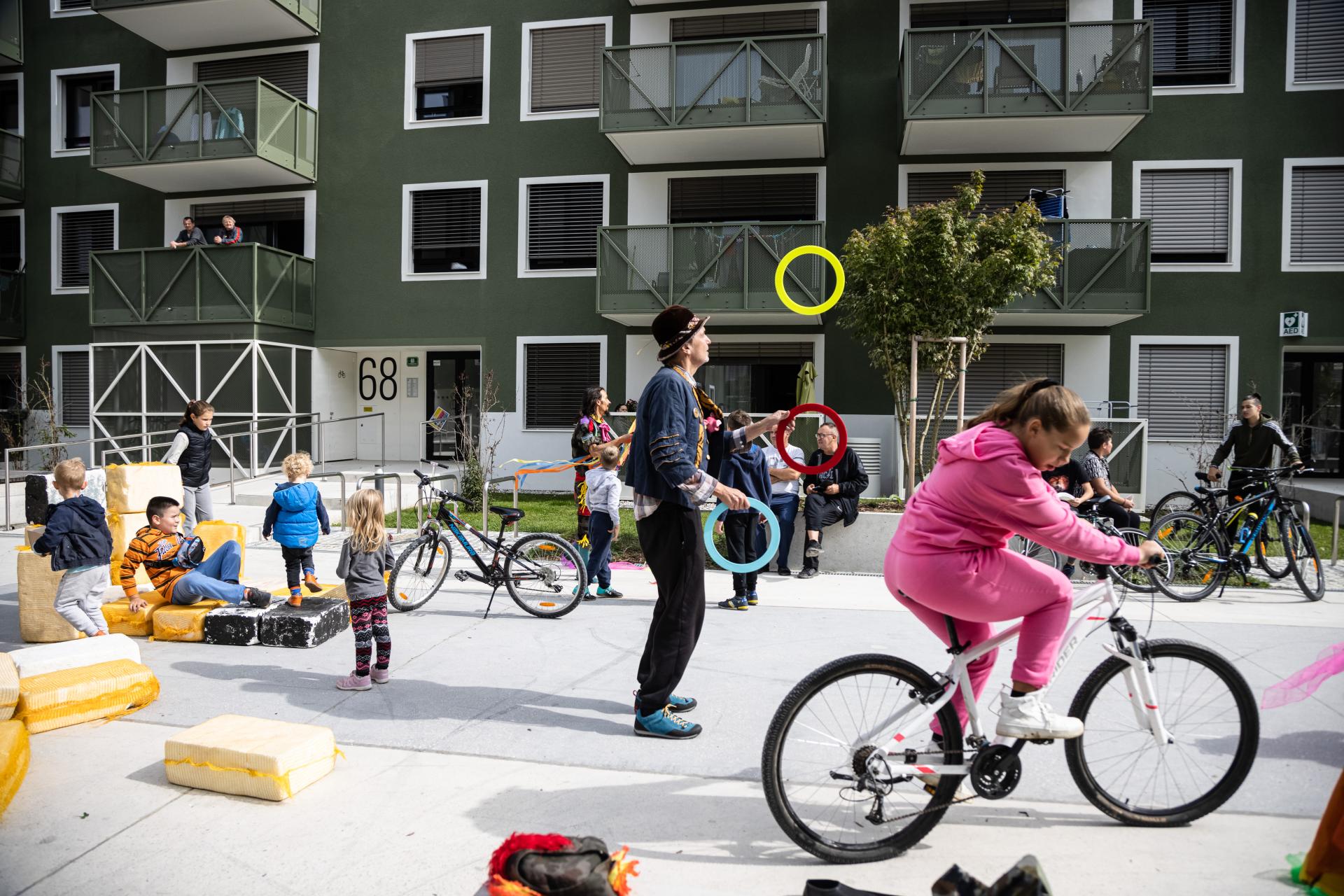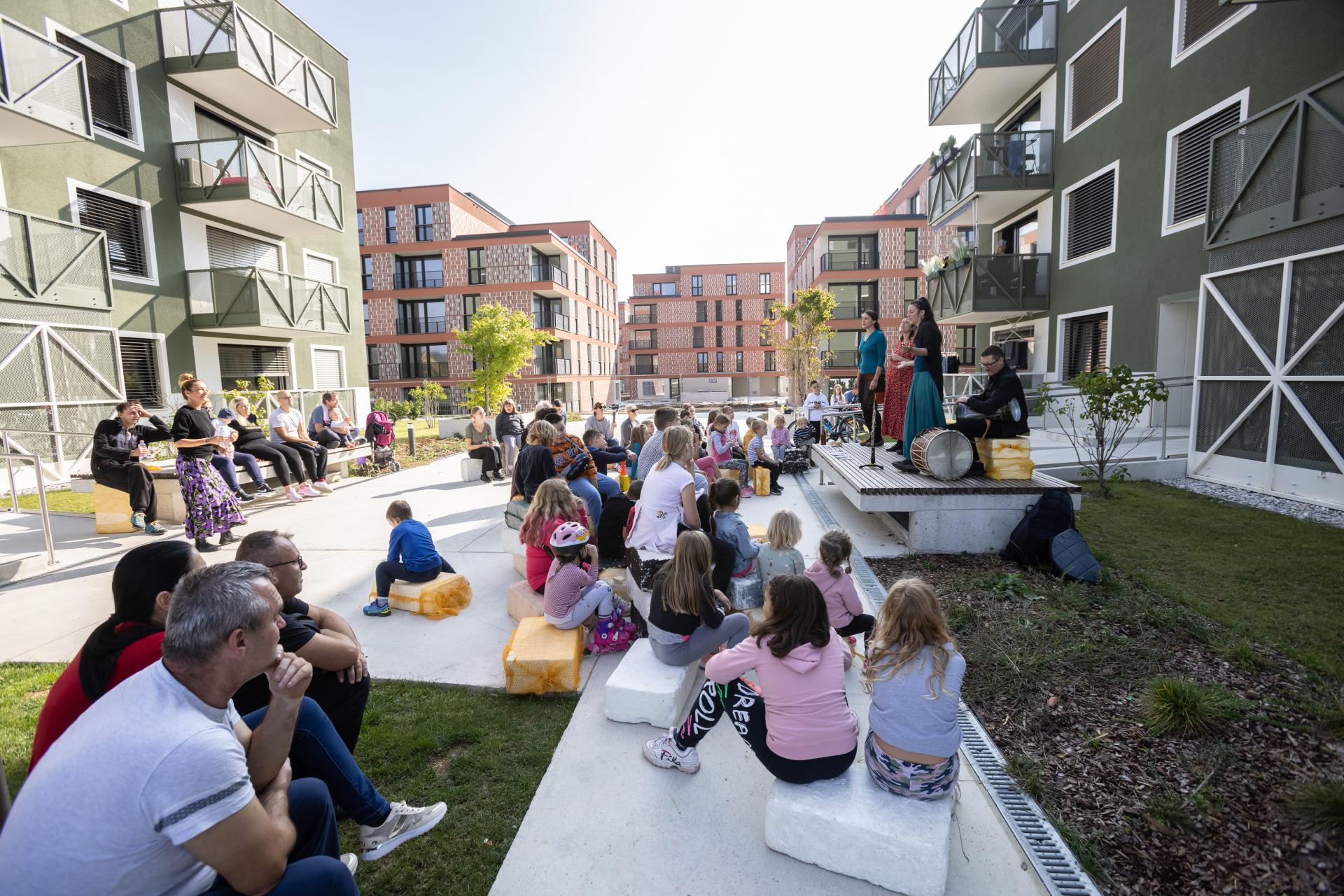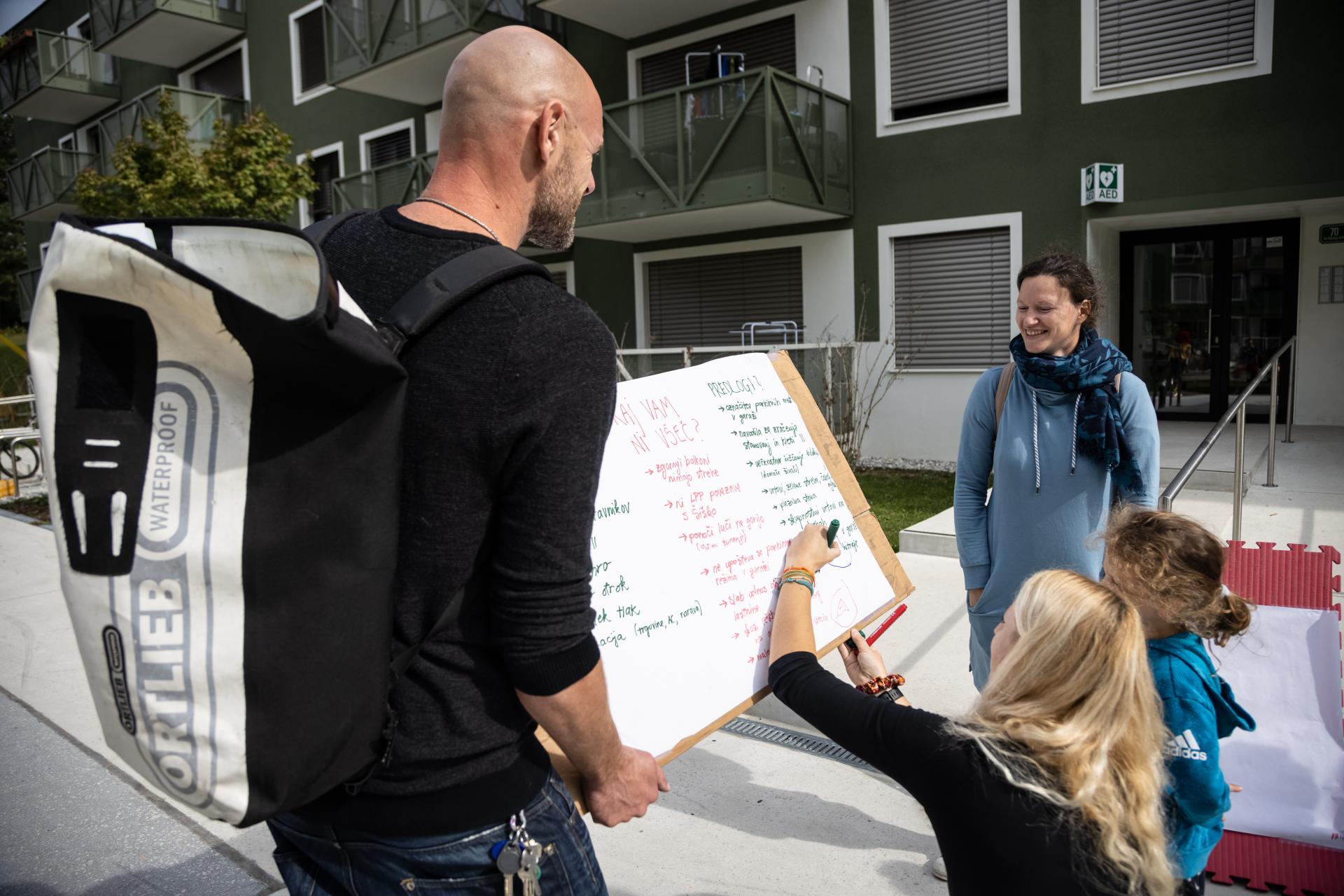ART YARD
Basic information
Project Title
Full project title
Category
Project Description
The doorstep theatre project Art Yard is a format that innovatively connects theatre creation in public space with social engagement. It is art that builds communities! With its help, we at Ana Monro Theatre address people that might be very different from one another, but live in a mutual local space, and help them connect, develop a cooperation among themselves and among different generations and, as a result, encourage building of communities in newly-built housing estates.
Geographical Scope
Project Region
Urban or rural issues
Physical or other transformations
EU Programme or fund
Which funds
Description of the project
Summary
The aim is to use performing arts to help forming bonds between fresh residents of the newly-built neighbourhoods. On their communal spaces we organize a 12-day cultural and social program for residents to meet with contemporary performative street arts in the home environment, which they rarely or never met before.
One of the main features of street theatre is personal communication between the artist and the audience member and we use it to encourage interaction between the locals of all generations – to connect them and to build trust and start forming a community.
The multi-day event has following contents:
- Advance visit of the neighbourhood to get-to-know the residents;
- Slow artistic penetration in the community, where artists in the style of a town crier announce the event and start connecting with inhabitants in person;
- Promotion – every household gets a leaflet, with local children helping distributing them. Many posters are hanged around the perimeter;
- Decoration of the space to create the festive atmosphere;
- Artistic event/performance opens the space and communication. We also stream the event over internet to reach the more shy or sceptical residents;
- Series of smaller events and workshops under the guidance of artists and craftsmen;
- Neighbours’ day – a whole-day event with a variety of animations, shows, concerts, games, food and workshops where residents can have fun together, get-to-know one another and start friendships;
- Surveys – during the last day we conduct several surveys – from the questions of quality of life and possible problems in the neighbourhood to the satisfaction with the event;
- Report – after the event an extensive report with visuals is prepared. The report and results of the surveys are presented to the neighbourhood manager to help them with better management and enable them understand the inhabitants better. Report is distributed to many stakeholders in the field of civic society, governement and art.
Key objectives for sustainability
The primary goal is to connect residents in new housing estates, to invite them to mix and mingle, to enjoy their communal spaces. And, what is extremely important in these (post)covid-19-times, to step over individual differences, lower barriers and rekindle mutual trust. In this way, we believe, we can help (re)building local community, using performing arts as a primary tool to achieve our goal.
The response from residents is very good. We recognize the sustainable effect of the Art Yard project in sowing the seeds of community, or at least drawing attention to the possibility of its existence. It inspires some individuals and at the same time empowers them to further promote and develop interaction, cooperation, socialising and networking between residents. These can become an important driving force for (re)construction of the neighbourhood community or the core of it.
The proceedings of the project are also useful to the neighbourhood manager and local government agencies to learn about the troubles and possible problems on site and improve life standards in the neighbourhood.
Therefore, we believe that Art Yard is a successful and effective circular art format for establishing and strengthening social contacts among residents, which can make a sustainable contribution to connecting them to a community!
We understand the circularity of the project in its perpetuality as it grows in circles – the results of this Art Yard process will be the input for the next one in some other community. The innovation is the duration of the project – it is rather fast and big. We believe that it is also very effective in comparison to the more usual long-term small-scale projects. We also understand that by preparing and disseminating the thorough reports and surveys, publicly and free of charge, it can serve as a blue-print and guidance for future examples done by other organizations as well.
Key objectives for aesthetics and quality
In the neighbourhood we use urban scenography interventions to change the common grounds into a festive event space. With an artistic street theatre show we open this space and invite people into it. The show addresses the feelings, hardships and concrete living situations that residents of new housing estates (may) face due to just having started to live in a different environment and among strangers. This is done in an understandable, entertaining, non-accusing and non-burdensome way.
As part of the Art Yard project, the event space is not just a stage for art, but is also a space for meeting, socialising, connecting and (co)working. Art Yard therefore goes beyond the aesthetics of theatrical creation in public space and becomes a kind of sociological laboratory that allows a special experience to happen for creators and residents.
It is an innovative format and process that addresses the individuals both as consumers of cultural and artistic contents and in the same time as members of the local housing community. It encourages them to contemplate about their engagement in the community and can change their respective perception – re-direct it from in-wards to out-wards and to-wards the neighbourhood community.
Art Yard is a typical example of the artistic aesthetics of the Ana Monro Theatre, based on genuine, direct and warm communication and empathy as well as pursuing the goal of connecting people into a community. We really enjoy our work, we love being among people or with them, and their experience is most important to us. We believe that we are or can therefore be an example to other artists on how to offer people something new, unique and valuable.
Key objectives for inclusion
The project is designed as a developmental process in which we encourage neighbourhood residents to get involved. The residents for us are not just our guests or spectators, but active (co)creators of events.
We include them in the organisational and implementational phase (promotion, preparation of venues, assistance in organising visitors and props and similar) as well as in the creative delivery phase (involvement in the shows and workshops, co-creation of entertainment, conversations about what they liked and did not like, or what and how to change in the course or content of individual events or programme units).
The cultural and social programme addresses residents of all ages, nationalities, educational degrees, social classes, religions and cultural backgrounds – with the aim of establishing social contacts and building interpersonal or neighbourly relations that will help them connect in the long run, across all possible barriers.
As part of the Art Yard project, we also address residents who do not attend events in the courtyards or communal venues, but follow them from the windows and balconies of their apartments. We are especially pleased when some of them get encouraged to actually join the events in person at later stage.
All events within the Art Yard project are freely accessible and free of charge for residents. This is important for the fact that quite a few of them have lower income. It is also important to point out that most apartments in the residential estate of our first rendition are classified as social housing.
The majority of the communal spaces are flat surface and also accessible for people with physical disabilities. Where physical access was an issue, we organised inhabitants to help, which they gladly did. There were also a few children with minor learning disabilities, but they were fully incorporated in all events, since our crew is experienced in working with them and including them into our audiences.
Results in relation to category
The feeling of belonging is even more important than usual in the so-called new reality. During the (too) long period of the covid-19 virus epidemic, people started to socially alienate from one another and close themselves into bubbles that are difficult to break. People do want to break them, though, it seems, for the residents of the neighbourhood we visited have expressed that they want and need more events like Art Yard. And we believe that this proves and confirms that the project was successful and effective.
In the final event we conducted a survey among the residents. The results show that for the vast majority our project was a new, pleasant and interesting experience. Everyone we talked to liked the idea of bringing theatre to their backyard. And most importantly – within the project they have made new acquaintances with fellow residents and Art Yard event (re)strengthened their sense of belonging to the community of their neighbourhood, both physical and spiritual.
The experience has shown that children and young people are more likely to be actively involved in the programme, so one specific focus of developing the project further for the future renditions, will be to find ways to attract and involve many more adults into active participation.
We recognize the sustainable effect of the Art Yard project in sowing the seeds of community, or at least drawing attention to the possibility of its existence. It inspires some individuals and at the same time empowers them to further promote and develop interaction, cooperation, socialising and networking between residents. These individuals can become an important driving force for (re)construction of the neighbourhood community or the core of it.
How Citizens benefit
Local residents assisted in choosing places for posters and hanging them; in distributing program leaflets; in preparing and cleaning venues; in organising props and materials for workshops. Those who were more enterprising and creative, however, were involved as volunteers in performances, workshops, co-creating animations. Also, some assisted in giving feedbacks, which helped to make preparation and execution easier and smoother. Their day-to-day feedback was very useful for us, organisers, to be more down-to-earth and residents-friendly.
For workshops and animations, we connected to several partner arts organisations and artists and invited them to explore different, new ways to use the public space and to develop new performative, pedagogical and communicational approaches, methods and tools. All this enabled them to find new types of audiences and grow artistically and personally.
In the preparation phase of the project and the aftermath, we connected to different official stakeholders in Ljubljana – City of Ljubljana’s Public Housing Fund, City of Ljubljana’s Office for Local Self-Government and City of Ljubljana’s Department for Culture. They were involved in different aspects of the project – spatial and financial management.
A special contribution is the cooperation with Slovenian experts from IPoP – Institute for Spatial Policies, who identified Art Yard project as an innovative method for involving neighbourhood residents in participatory processes of regulation and sustainable development of public/communal spaces. As part of our collaboration, they invented a specific method for interviewing in space, person to person, which they found very useful for their future use. The results of their survey greatly help City of Ljubljana’s Public Housing Fund to learn about the inhabitants’ opinions about living in their newly constructed neighbourhood and to possibly make it better.
Physical or other transformations
Innovative character
Below we offer a summary of various aspects of the specificity and innovativeness of the Art Yard project and point out the facts that distinguish it from usual mainstream practices. It:
- Brings theatre and street theatre to people's backyards;
- Reaches beyond pure artistic creation and builds a bridge to social engagement;
- Offers a new and attractive experience to people who do otherwise not attend cultural and social events;
- Encourages and/or strengthens the individual's interest in arts and culture as well as in socialising in general;
- Changes the leisure habits of the addressed individual/family/community;
- Encourages interaction, connection, cooperation, socialisation and getting-to-know one another among local residents;
- Is an innovative form of developing and/or strengthening social dialogue and neighbourly relations;
- Transcends all divisions and addresses all residents;
- People are not just visitors and spectators, but co-creators of events;
- Contributes to the building of the local community and, through it, to the resocialisation of the whole society;
- Promotes social cohesion over different generations of inhabitants;
- Is a kind of artistic experiment in the form of traveling theatre and sociological research at the same time;
- Is a strategic tool for contemporary performing artists to reach out for new audiences, open up different urban spaces, create innovative artistic approaches and forms of production – it enables them artistic growth;
- Ensures a further development and existence of street theatre;
- Is an event that goes further than the usual consummation of culture, because it includes components of collaboration, socialisation, learning and many others. It is a unique experience.
Learning transferred to other parties
One rendition of the project is finished and now it is the intention of Ana Monro Theatre to go on with it, develop it further and adjust it, respecting the results and experiences gained in each new rendition. There is so much to learn – about our artistic practices, about better ways of collaborating with local residents, about deepening the cooperation with other stakeholders, artists and others.
One of the key elements of the project was a creation of a written report that anyone can download from our webpage and read. In the report, we gathered all the experience, survey results and visuals of the project.
We have sent the report to everybody who cooperated and to many other stakeholders. As a response, we have received a commendation letter from Zoran Janković, Mayor of the City of Ljubljana, and quite a few invitations for detailed and personal presentation of the project from different organisations in Ljubljana region. We already have some actual invitations for collaborations. In March 2022, we will devise a new inclusive and collaborative game for the opening ceremony of the Community Centre Borc on the outskirts of Ljubljana. This game will also become one of the backbones of future Art Yard renditions.
All the information, including goals, ways of execution, methodologies and surveys are freely available on our webpage, also in a downloadable form. We are open to any kind of collaborations and willing to share our experience and knowledge.
We are in the process of learning and discovering the joys and pitfalls of the ART YARD project and are keen to make new discoveries in joining doorstep theatre, specific local public spaces and their residents into one (or many) enriching community and create unique experiences!

